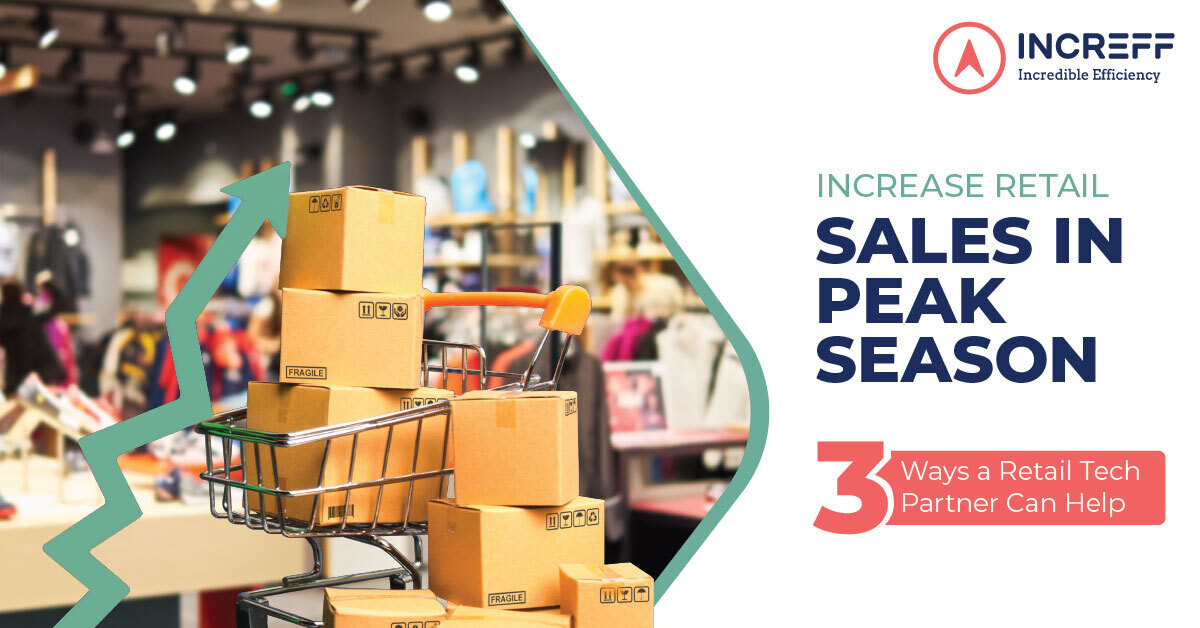As we navigate through the uncertainty of our current times, the age-old adage, “necessity is the mother of invention,” proves accurate once again. Retail businesses are experiencing an unprecedented era of turbulence – inflation is mounting, consumer behavior is evolving at an astounding pace, and the retail landscape is shifting, necessitating more agile, innovative, and sustainable approaches.
Faced with these challenges, how do retailers keep their heads above water? The answer lies in adopting advanced technologies.
#1 Challenge: Can algorithm-driven approaches help in decision-making?
In today’s dynamic retail landscape, businesses have realized that data is not merely an offshoot of transactions; it is a treasure trove teeming with invaluable insights. The hero of this evolving narrative is algorithm-driven retailing, where the alchemy of advanced analytics transmutes raw data into actionable insights, facilitating strategic decisions in the blink of an eye.
As per Gartner’s estimations, by 2025, algorithmic retailing is set to unlock over $1 trillion in the total value for retailers. This powerful approach tackles the intricacies of consumer behavior, seasonal patterns, market realities, and supply chain trends with unparalleled precision.
Recent research by Harvard Business Review (2023) reveals the transformative impact of this data-driven approach – retailers leveraging algorithmic merchandising have witnessed a significant 15% boost in average order value and an impressive 25% uptick in customer retention rates.
The forward-thinking predictions by Gartner further underline the potential of algorithm-driven retailing. Moreover, it equips retailers with unmatched agility to respond to market shifts. The swift and precise decision-making capability powered by algorithms allows businesses to adapt their strategies promptly and effectively, confronting the hurdles of inflation and supply chain disruptions.
An often underappreciated aspect of algorithm-driven retailing is its contribution towards environmental sustainability. By finessing order quantities and curbing overstocks, it reduces waste and fosters eco-friendly business practices. By 2025, it’s estimated to diminish out-of-stock situations by a staggering 80% and escalate inventory turns by 25%. This data-powered strategy enhances customer satisfaction and profitability by accurately forecasting demand, fine-tuning pricing, and deftly curating product assortments to mitigate the risk of overstock or stock shortages.
By harnessing the power of advanced algorithms, businesses can predict demand with higher accuracy, optimize pricing, and deliver personalized customer experiences on a grand scale. In essence, adopting algorithm-driven retailing is akin to having an indefatigable retail scientist working round-the-clock, continually refining your business operations.
#2 Challenge: Can automation and digitization improve warehouse efficiency?
As the heartbeat of a retailer’s operations, warehouses are transitioning from traditional stockrooms into technologically advanced nerve centers, bolstered by the power of automation and digitization. This revolution is not only redefining the nature of warehousing but also underlining its strategic role in today’s competitive retail landscape.
According to a report by LogisticsIQ, the warehouse automation market is expected to grow from $14 billion in 2020 to $30 billion by 2026, with an impressive CAGR of 14%. These figures underscore the robust trust and investment businesses are placing in warehouse automation and digitization.
Automation delivers unprecedented operational efficiency. It streamlines workflows, reduces errors, and dramatically enhances productivity. Furthermore, manual tasks such as order picking, packing, and shipping can be automated, freeing up valuable human resources for strategic tasks and decision-making.
Digitalization, on the other hand, provides retailers with real-time visibility and control over their inventory. With digital systems, businesses can track product movement, manage stock levels, and respond to changes in demand promptly. According to Zebra Technologies’ Warehouse Vision Study, 77% of decision-makers plan to invest in Warehouse Management Systems (WMS) and digitize their inventory, picking, packing, and restocking processes by 2024.
Moreover, automation and digitalization facilitate predictive analytics, enabling businesses to anticipate future trends, manage resources effectively, and make data-driven decisions. This ability to anticipate and respond to market fluctuations can offer retailers a significant competitive advantage in the dynamic world of e-commerce.
#3 Challenge: Can stores address fulfillment challenges?
In the ever-evolving retail landscape, the boundaries between online and offline shopping are rapidly fading. As consumers demand faster deliveries and better availability of products, retailers are forced to rethink their fulfillment strategies. But amidst this transformation, a new model called “fulfillment from store” is emerging, offering a glimmer of hope for sustainable retailing.
Imagine a symphony of brick-and-mortar stores that serve as more than just customer engagement points. These stores become dynamic micro-fulfillment centers, poised to deliver products with unprecedented speed. This vision is becoming a reality as retailers redefine their physical stores as local distribution hubs, unlocking their incredible potential.
One of the remarkable benefits of the “fulfillment from store” model is the drastic reduction in last-mile delivery costs. McKinsey reports that last-mile delivery expenses account for a staggering 41% of total supply chain costs. By utilizing physical stores as fulfillment centers, retailers can significantly cut down on these expenses. Not only does this lead to cost savings, but also contributes to the reduction of carbon footprints, laying the foundation for a more sustainable retail ecosystem.
Furthermore, this model empowers retailers to bring products closer to their customers, resulting in faster delivery times. The Forrester Institute conducted a study in 2023, revealing that retailers adopting the “fulfillment from store” model reduced their delivery time by an impressive 27%. This not only enhances customer satisfaction but also fosters customer loyalty, as shoppers value swift and reliable deliveries.
Additionally, the consolidation of online and offline inventories enables retailers to optimize their stock levels, reduce overstock and markdowns, and avoid the detrimental effects of out-of-stock situations. By harnessing the power of technology and strategic inventory management, retailers can create a harmonious balance between meeting customer demand and minimizing waste.
While the “fulfillment from store” model holds great promise, challenges remain, particularly within the fashion industry. The implementation of store fulfillment strategies in marketplaces has been constrained primarily by technological limitations. Brands encounter difficulties in deciding which products should be made available on which retail channel and incur elevated expenses when delivering individual items from stores to customers’ residences.
However, with innovation and collaboration, these challenges can be overcome. Technological advancements can empower brands to streamline their inventory management systems, ensuring that the right products are available online and in physical stores. Collaborative efforts between retailers, logistics providers, and technology companies can help drive down the costs associated with last-mile delivery, making sustainable retailing a viable reality.
Ultimately, achieving sustainable retailing requires a collective effort from all stakeholders. Retailers must embrace innovative fulfillment strategies, leverage technology to optimize inventory and forge partnerships to address logistical hurdles.
#4 Challenge: Can sustainable retailing be truly attainable?
As we navigate through challenging times, the issue of greenwashing has become increasingly prevalent in the business world. Greenwashing refers to the deceptive practice where companies make misleading environmental claims, leading consumers to believe that their products or services are eco-friendly or sustainable when in fact, they are not. Beyond being a matter of bad business ethics, greenwashing undermines the collective efforts to reduce the environmental impact of human activity.
In order to truly achieve sustainable retailing, it is crucial for companies to move beyond greenwashing and embrace genuine environmentally friendly practices. One key aspect of sustainable retailing lies in the use of advanced technology. By incorporating cloud-based inventory management systems, retailers can minimize waste by accurately matching supply with demand. This reduces the need for overproduction and excess inventory, thereby decreasing environmental harm. Furthermore, algorithmic retailing can optimize logistics and transportation routes, leading to a reduced carbon footprint for the retail industry.
The Retail Industry Leaders Association (RILA) has reported that retailers utilizing advanced technologies have successfully reduced greenhouse gas emissions by 19% in 2022 compared to previous years. This showcases the positive impact that embracing sustainable practices can have on the environment. By adopting these technologies, retailers not only benefit their bottom line through increased efficiency but also contribute to the overall goal of achieving sustainability.
However, sustainable retailing goes beyond technological advancements. It requires a holistic approach that encompasses various aspects such as responsible sourcing, ethical manufacturing practices, waste reduction, and the promotion of sustainable products and services. Companies need to be transparent and accountable in their environmental claims, ensuring that they adhere to recognized standards and certifications that validate their sustainability efforts.
While sustainable retailing poses challenges, it is not an unattainable goal. It requires a shift in mindset and a commitment from companies to prioritize environmental responsibility over short-term profits. Consumers also play a vital role by demanding transparency and holding companies accountable for their environmental claims. By supporting genuinely sustainable brands and products, consumers can drive the market toward a more sustainable future.
Innovate or fall behind – The ball is in your court
The retail industry stands at a critical crossroads. As challenges mount, technology emerges as the lifeline for survival and prosperity. The path forward may be challenging, but the promise of advanced technology illuminates the way. To thrive in the future, retailers must wholeheartedly embrace these transformative technologies. It is no longer a choice but an imperative for survival and growth. The time is now to adapt, innovate, and harness the power of technology for a successful future in the ever-evolving retail landscape.



